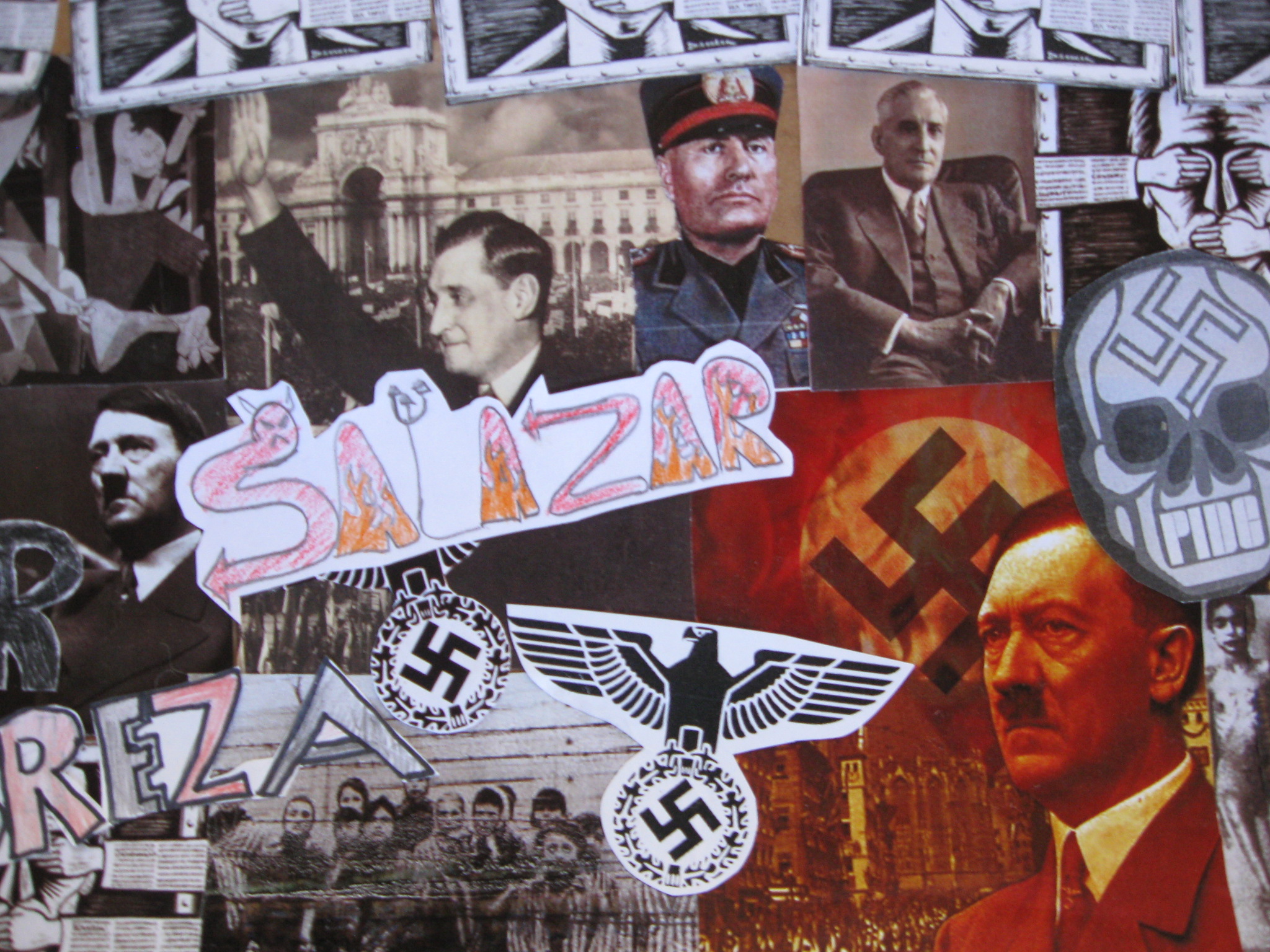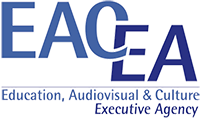Frei Bartolomeu dos Mártires - Portugal
Region: Viana do Castelo
Other schools in the Quint Blog: Koskelan Koulu (Finland), Magic Hill (Czech Republic),Mater Dei National School (Ireland), Shottermill Junior School (UK)
Creative Connections Project: Art, Identity and Tradition
Background
This case study describes a curriculum development action and research project called Creative Connections (CC), in which the Higher School of Education at the Viana do Castelo Polytechnic was involved along with a Basic Education art teacher and twenty students (12 girls and 8 boys) from one class (5ºA), from an urban middle school (students aged 10-15) in Viana do Castelo, Northern Portugal. The participant teacher in the school-based team concerned also has an Art Education background and is keen to experiment with creative ways of teaching and learning art across the curriculum. The informatics technician, working at the Escola Superior de Educação (ESEVC), has supported the Skype meetings and blogs between the Portuguese and the Czech teams (the art teacher, and her students), and the use of the Connected Gallery.
The curriculum action was conducted in a basic education school in Viana do Castelo. (primary and secondary) is located in Santa Maria Maior, a parish of 2.32 square kilometres, with 9,940 inhabitants. The student population is predominantly Catholic and this school has a small percentage of newcomers/immigrants from Eastern Europe, East Asia and Africa. The majority of parents have completed secondary but not higher education. In the class three students had special needs and were supported by special needs education technicians. The curriculum action in this school was implemented by, an art teacher who has been collaborating with Escola Superior de Educação for more than 20 years, as a supervisor of art teachers and as a research member in a previous international project entitled Images and Identity. Twenty students participated, aged between 10 and 11 years old.
Aims and Framework
The art teacher attended the training day at ESEVC, in September 2012 and she has selected the topic ‘Art, Identity and Tradition’ as a focus for an action underpinned by some of the source material created by the team of the Images and Identity (I&I)international Project, developed from 2008 to 2010. The task of recording the sessions was developed by an external observer, who has been invited for collecting data throughout the action research. His discussions with students were video-recorded and provided fundamental feedback to the art teacher and to the national coordinator. All data collected included:
- observation
- teacher’s diary
- students’ oral/written comments
- art productions
- internet blog contacts between students
- skype meeting between Portuguese and Czech teams
- semi-structured interview with the art teacher
The observations were registered in accordance with a list of topics:
- teacher’s curriculum intervention
- students’ attitudes when carrying out activities
- cultural and social understanding of the world in which the students live
- making students familiar with contemporary social issues, using European art
- knowledge of art theories.
The Study
The teacher adopted the action research method, and the classroom action took place for one 90 minute weekly session over a period of eight weeks, with a structured approach which included the concepts of ‘contemporary art’, ‘identity’, ‘tradition’ and ‘democracy’. Permission was obtained from parents and direction of the school, to photograph the students whilst working and to include this evidence in the Creative Connections report. The national coordinator collaborated with the art teacher on planning.
Research in Action
The first step of the Project included students’ work focusing on individual aspects (e.g. their name, age, home, family, personal tastes, own town, and others) and they looked at Self-Portrait a painting of José de Guimarães, a Portuguese artist that had collaborated in the Images and Identity International Project. The image of this work was collected in the Connected Gallery. The second step of the project involved the debate about the concept of national identity, for instance:
- traditions
- dishes
- music
- literature
- sport
- public figures
- landscape
- architecture
- national symbols and others
Students observed and talked about art works of European artists such as Sean Hillen, The Oracle at O'Connell Street Bridge, (Ireland).
Teacher’s comment:
Students created a collective panel, in order to describe, analyse and critically explore visual images from different sources, such as internet, newspapers, magazines, written words that emerged as a synthesis of the debates about the present and past situation (World War ll) of Portugal and Europe. Thus, this work presents the formal structure of the work of Sean Hillen, which includes the analysis of the evolution of a city, past, present and future) and includes the students’ about the present Portuguese and European situation (The recent past - Europe and the great dictators of the 21st century, Portugal and the 25th April Revolution, the present and future - the euro crisis, social instability, anger, lack of values established by democracy, the dominant political, power money)
The teacher’s action research progressed from an initial exploration of identity-related issues and students were particularly motivated discussing their local issues, and voiced the opinion that personal identity is constantly transformed by external factors such as media and travel. The students also reflected on communal identities with a strong emphasis on local and global terms and they explored the interrelated topics of identity and citizenship. The ready availability of source material connecting to Portuguese and European history and art from the 20th century till now, have encouraged students to talk about citizenship values and respond to a number of key questions such as:
- What ideas, feelings and emotions can we express through art?
- What kind of words do you relate with Portugal and Europe nowadays?
- What is the meaning of the concept of identity?
- Who am I and how am I different from the others?
- Who are we and how can we be characterized as a nation?
- Can you recognize the expression of identity in an art work?
- How can the concepts of identity, art and tradition be articulated in a collective art work?
Students were able to apply their knowledge and skills gained from this project in an educational and artistic setting and they demonstrated a thorough, detailed knowledge of the citizenship concepts, reflecting a relatively intensive study of the subject and communicating effectively with their colleagues and teacher in a teaching/learning situation. They discussed historical issues with a local, regional and national cultural, artistic and political impact, and they explained the meaning of art and European identity concepts, using their written and oral communication skills. They talked about their own traditions and cultural experiences and they produced a two dimensional piece of work exploring their own cultural identity. They shared all this learning experience with other Czech students and teacher through a Skype meeting and blogs. Their critical artistic sense was promoted by analysing works of art and reflecting into whether their ideas had changed as a result of such discussions.
Finally, the choice of collage as the preferred art medium helped them to apply their artistic and technological skills effectively for citizenship education purposes, through representation of political issues in a collective wall panel. But what changed as a result of the action? Data was considered and analysed qualitatively by content analysis with regards to curriculum intervention and students attitudes.
Curriculum Intervention
The strength of this curriculum intervention was that it examined the role of dialogue in the educational work oriented toward civic education through the arts. The data analysis depended to an extent on evidence cognitively expressed in the weekly responses to the key questions and strategies. All data was analysed and interpreted and the personal identity and cooperation of each student was respected. The action research allowed the teacher to gather detailed and extensive information from a sample of 20 students. It became clear that the students were very motivated and that the project provided more enriched and meaningful experiences of art. During the implementation of the action research, the teacher could observe students’ attitudes and behaviours regarding contemporary art and citizenship concepts and concluded that formalist approaches should not have a place in the future in her art classes. She said:
Modernist theories are limiting because they are not adequate to study postmodern art. The content of my discussions with students emphasised interpretations that relate artwork and society and by studying the social and cultural context of the selected artworks, students were able to reflect upon and even question their beliefs and values.
Other significant findings not envisaged by planned research, but spontaneously arising from it were related to the opportunities the students need to produce art beyond the scope of creative self-expression. The observations also showed that the teacher has considered it pertinent to develop a cross cultural understanding approach. This teacher argued that the different strategies were very important for the success of the project. Criticism in the art curriculum was felt as a fundamental component, as well as the use of language, which involved the development of an active vocabulary. Evidence has been gathered in the qualitative analysis of students’ oral and written work, which shows the positive effect that engagement in critical activity had on students’ final collective panel.
One student said:
The past had to do with the lack of human rights, the time of the dictatorship, European Dictators, the current crisis and the future was represented by the buildings with notes, euro coins, because money rules.
This team has considered the artwork similar to texts and the reading of the different images involved, in semi-optic terms, interpretation, decoding questions throughout the weekly debate. This strategy helped all the team to focus on the effects of power in validating knowledge of art, using deconstruction technique in analysing and recognising multiples codes that the artworks can possess (Efland et al, 1996). The teacher also used analysis of mass media images as a stimulus for the kind of dialogue that enabled the introduction of the citizenship concepts.
Students’ Attitudes
Motivation by means of the Connected Gallery had facilitated the contact with artists from different cultural contexts. The teacher said that not enough opportunity and/or time for using the blog strategy was given to students. She felt that the international communication should be included in the art classes and blogs and should have been part of the teaching learning process. This should avoid the superficial and poor comments of students. Regarding cultural and social understanding of the world in which the students live, I agree with Silva (2000) when he states that engaging students in interaction and communication with European colleagues can function as a crucial resource for developing students’ powers of cross-cultural understanding. The comments recorded in the diary by the teacher and the external observer show that the dialogue and image analysis’ strategies have helped students to become more familiar with contemporary social issues, and European art. Success indicators can be summarised as the following:
- students’ development of notions of European identity through image analysis
- learners’ engagement with European contemporary art work
- culturally diverse educational ideas
- the humanities-based, interdisciplinary, integrated approach
- easy access to the European image bank and resources (e.g. Images & Identity project) that promote lifelong learning
- flexible content, connected with everyday life
- and promotion of interdisciplinary integration
The teacher commented:
It was very important for me the development of international exchange and cooperation, which promoted standards of academic research, artistic creativity and more quality of teaching.
Reflections
The implications of this small-scale action research for European students, and specifically for this Portuguese team is that schools must create more opportunities for all the students to tell their story, so they can
- Learn about another identity
- Understand one another’s identity
- Be aware of the factors that shape our identity
- Develop beliefs and behaviours of human rights, citizenship values among all the members of the school community
- Accept one another’s differences
- See the importance of image analysis as an educational tool and an opportunity to reflect upon students personal, local and national stories (see Fig. 1)
Citizenship education through the arts needs a perspective which places ‘art in contexts’.
The teacher said:
Students joined the two proposals and participated enthusiastically in lessons with great commitment and dedication, expressing keen critical sense and concern at the current situation of the country and Europe. I have never seen students so politicised but I believe that their families and the media had a great influence on their awareness about this topic. The money rules, Teacher! (this was a comment from a student ten years ago, during one of the many discussions that the project provided.)
The need for such an approach is recognized by Allison (1988), which affects ‘not only the aesthetic health of society in individual and community terms, but also the economic, industrial, social, cultural and political dimensions of life today’ (p. 182). It is an effort to draw together the many strands of thought that have developed in this project, and to reflect upon them against the backdrop of a small-scale empirical study carried out in this middle school. In order for the community to be formative, there must be openness among its agents for change, through a constant interaction and interdisciplinary action, working with students on a generative topic in order to promote critical consciousness, with an emphasis on students’ historical reality, as a serious strong tool in the pedagogical activity for citizenship education. When students are given the opportunity to have regard for their past, to reflect upon it in the context of the present, they are enabled to grow towards a more rich future life in their own environment.
A 10 years student said:
I enjoyed doing the collective panel because we can show what we think about our country and also how Europe controls our money.
The research also established that the national and international citizenship and art education theory and practice must be made accessible to the teachers in such a way that they can reflect on it and adapt it to their school contexts.
Fig.1 - Self-portrait - José de Guimarães (ArtWorkDatabase)

Fig.2 – Students’self-portrait
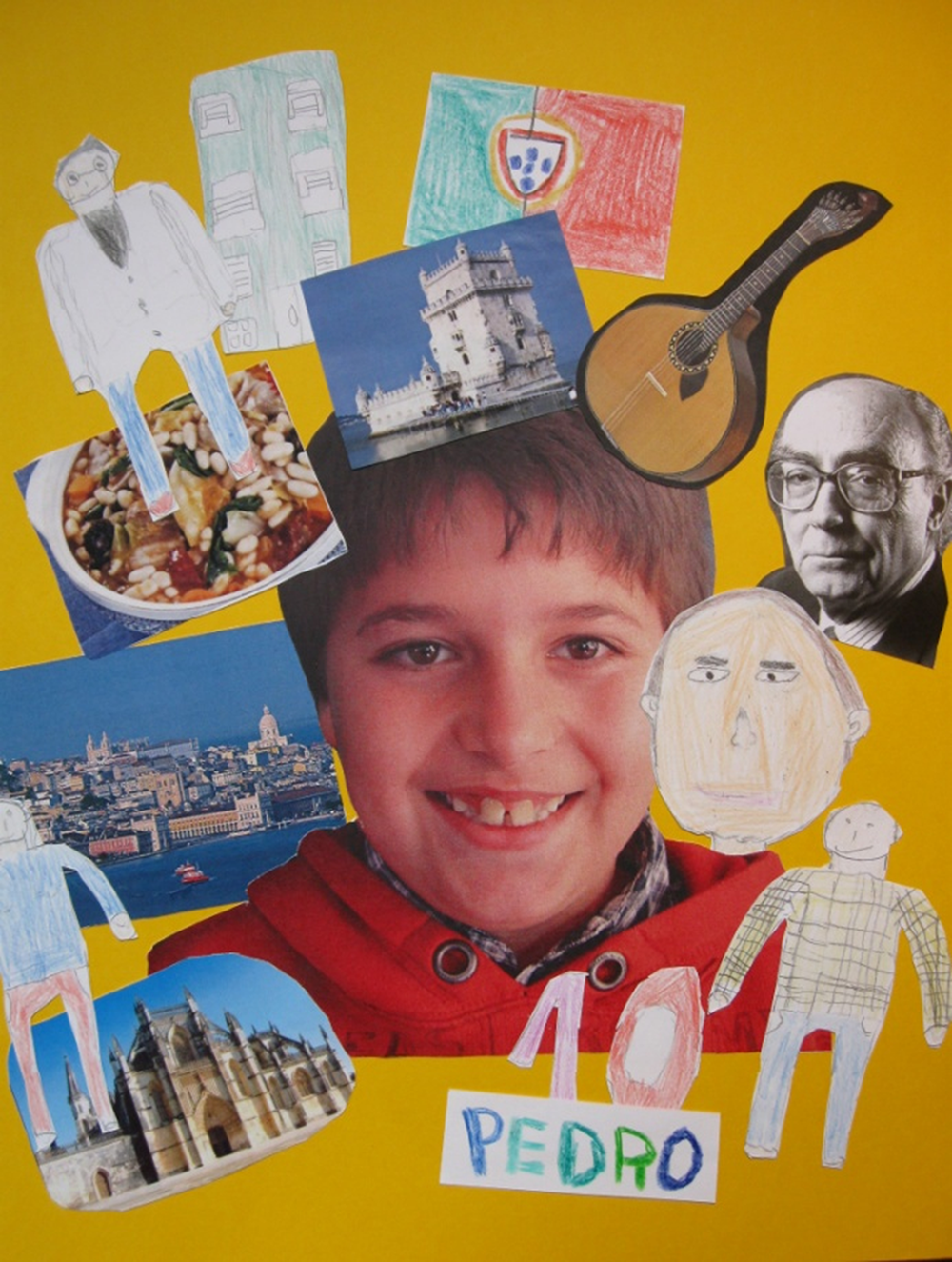
Fig.3 - The Oracle at O'Connel Street Bridge, Irelantis - Sean Hillen (ArtWorkDatabase)
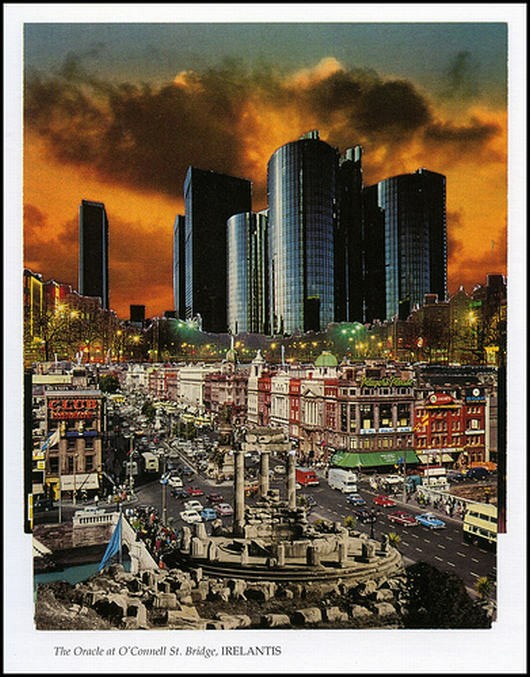
Fig.4 –Collective Panel - Final
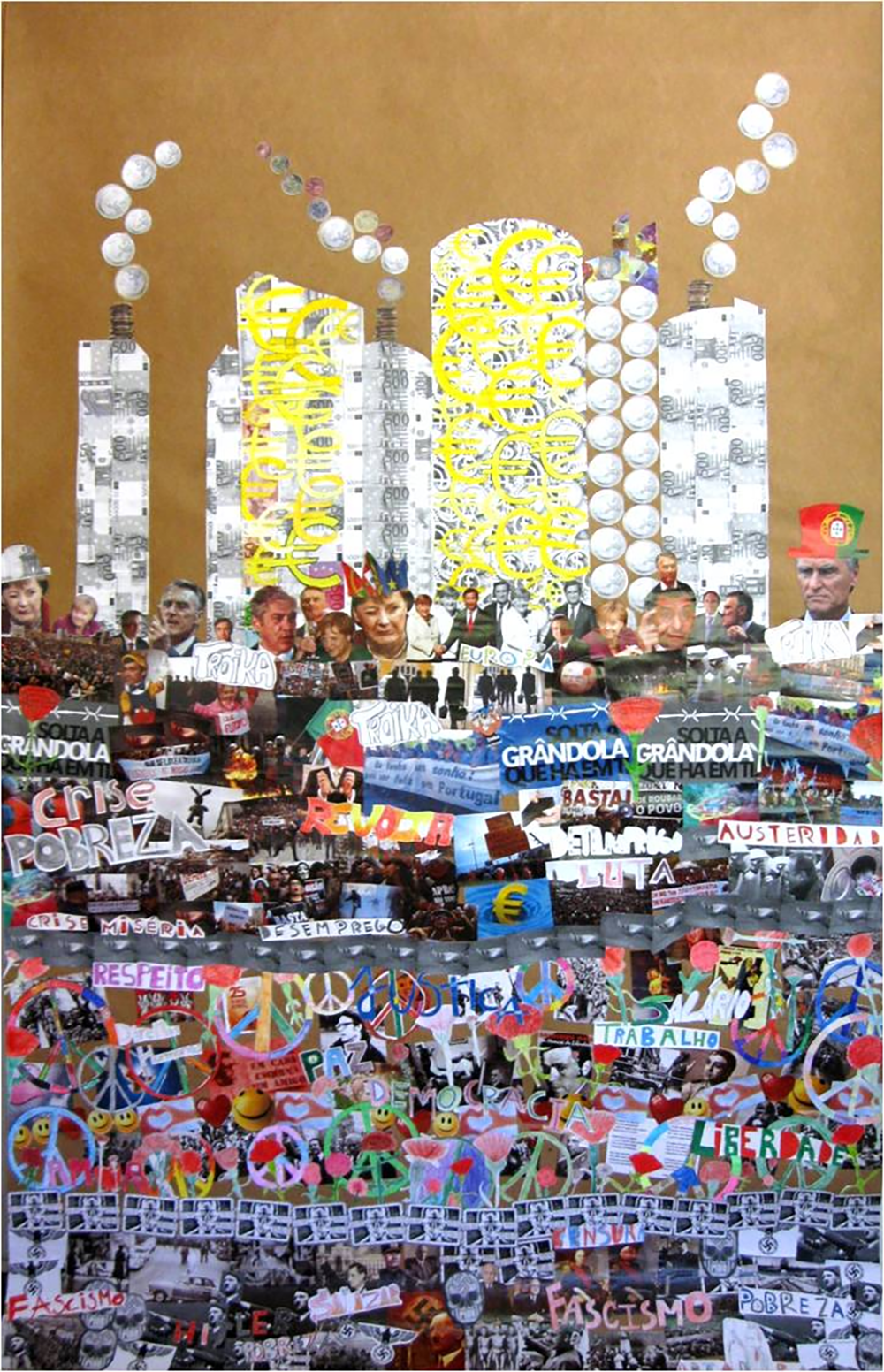
Fig.5 –Collective Panel - Detail
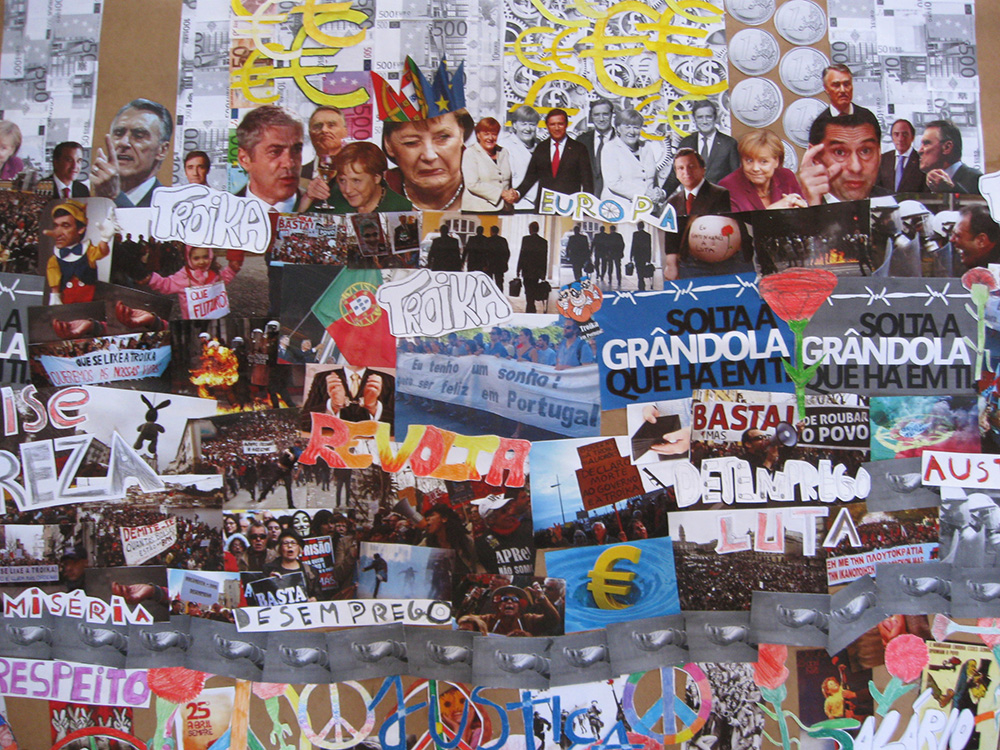
Fig.6 –Collective Panel - Detail
